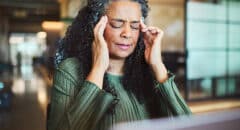 (BlackDoctor.org) — Bones are the framework for your body. Bone is living
(BlackDoctor.org) — Bones are the framework for your body. Bone is living
tissue that changes constantly, with bits of old bone being removed and replaced
by new bone. You can think of bone as a bank account, where you make “deposits”
and “withdrawals” of bone tissue.
During childhood and adolescence, much more bone is deposited than withdrawn,
so the skeleton grows in both size and density. Up to 90 percent of peak bone
mass is acquired by age 18 in girls and age 20 in boys, which makes youth the
best time to “invest” in your bone health.
The amount of bone tissue in the skeleton, known as bone mass, can keep
growing until around age 30. At that point, bones have reached their maximum
strength and density, known as peak bone mass. In women, there tends to be
minimal change in total bone mass between age 30 and menopause. But in the first
few years after menopause, most women experience rapid bone loss, a “withdrawal”
from the bone bank account, which then slows but continues throughout the
postmenopausal years. This loss of bone mass can lead to osteoporosis. Given the
knowledge that high peak bone density reduces osteoporosis risk later in life,
it makes sense to pay more attention to those factors that affect peak bone
mass.
Factors Affecting Peak Bone
Mass
Peak bone mass is influenced by a variety of genetic and environmental
factors. It has been suggested that genetic factors (those you were born with
and cannot change, like your gender and race) may account for up to 75 percent
of bone mass, while environmental factors (like your diet and exercise habits)
account for the remaining 25 percent.
Gender: Peak bone mass tends to
be higher in men than in women. Before puberty, boys and girls acquire bone mass
at similar rates. After puberty, however, men tend to acquire greater bone mass
than women.
Race: For reasons still not
known, African American females tend to achieve higher peak bone mass than
Caucasian females. These differences in bone density are seen even during
childhood and adolescence.
Hormonal factors: The hormone
estrogen has an effect on peak bone mass. For example, women who had their first
menstrual cycle at an early age and those who use oral contraceptives – which
contain estrogen – often have high bone mineral density. In contrast, young
women whose menstrual periods stop due to extremely low body weight or excessive
exercise, for example, may lose significant amounts of bone density, which may
not be recovered even after their periods return.
Nutrition: Calcium is an
essential nutrient for bone health. Calcium deficiencies in young people can
account for a 5 to 10 percent difference in peak bone mass and can increase the
risk for hip fracture later in life. Surveys indicate that teenage girls in the
United States are less likely than teenage boys to get enough calcium. In fact,
less than 10 percent of girls ages 9 to 17 are actually getting the calcium they
need each day.
Physical Activity: Girls and boys
and young adults who exercise regularly generally achieve greater peak bone mass
than those who do not. Women and men older than age 30 can help prevent bone
loss with regular exercise. The best exercise for your bones is weight-bearing
exercise. This is exercise that forces you to work against gravity, such as
walking, hiking, jogging, stair climbing, tennis, dancing, and weight
lifting.
Lifestyle Behaviors: Smoking has
been linked to low bone density in adolescents and is associated with other
unhealthy behaviors, such as alcohol use and a sedentary lifestyle. The negative
impact that smoking has on peak bone mass is further worsened by the fact that
those who begin smoking at a younger age are more likely to be heavier smokers
later in life. These older smokers are at further risk for bone loss and
fracture.
The impact of alcohol on peak bone mass is not clear. The effects of alcohol
on bone have been more extensively studied in adults, and the results indicate
that high consumption of alcohol has been linked to low bone density. Experts
assume that high consumption of alcohol in youth has a similar adverse effect on
skeletal health.
NIH Osteoporosis and Related Bone Diseases ~ National Resource Center
2
AMS Circle
Bethesda, MD 20892-3676
Phone: 202–223–0344
Toll Free:
800–624–BONE
TTY: 202-466-4315
Fax: 202-293-2356
Email: [email protected]
Website:
http://www.niams.nih.gov/Health_Info/bone/default.asp
The NIH Osteoporosis and Related Bone Diseases ~ National Resource Center
provides patients, health professionals, and the public with an important link
to resources and information on metabolic bone diseases. The mission of NIH
ORBD~NRC is to expand awareness and enhance knowledge and understanding of the
prevention, early detection, and treatment of these diseases as well as
strategies for coping with them.
The NIH Osteoporosis and Related Bone Diseases ~ National Resource Center is
supported by the National Institute of Arthritis and Musculoskeletal and Skin
Diseases with contributions from:
National Institute on Aging
Eunice Kennedy Shriver National Institute of
Child Health and Human Development
National Institute of Dental and
Craniofacial Research
National Institute of Diabetes and Digestive and
Kidney Diseases
NIH Office of Research on Women’s Health
DHHS Office on
Women’s Health.
The National Institutes of Health (NIH) is a component of
the U.S. Department of Health and Human Services (DHHS








